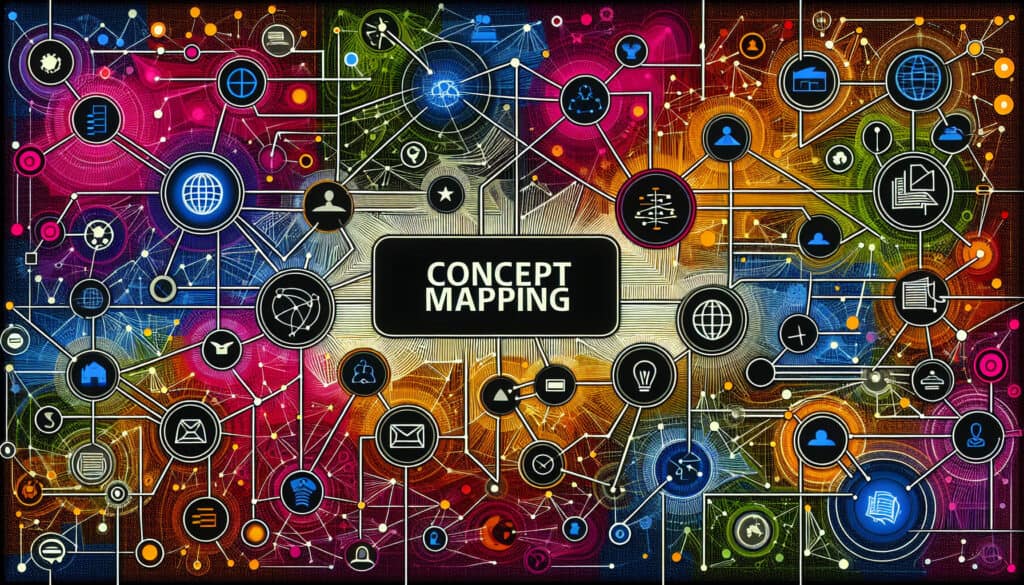Strumento grafico per organizzare e rappresentare la conoscenza sotto forma di diagramma.
- Metodologie: Clienti e marketing, Economia
Mappatura dei concetti

Mappatura dei concetti
- Brainstorming, Creatività, Pensiero progettuale, Ideazione, Design dell'interazione, Tecniche di risoluzione dei problemi, Linguaggio di modellazione dei sistemi (SysML), Progettazione incentrata sull'utente
Obiettivo:
Come si usa:
- Si tratta di creare una mappa visiva in cui i nodi rappresentano i concetti e i collegamenti le relazioni tra di essi. Si usa per il brainstorming, l'organizzazione della conoscenza e la risoluzione dei problemi.
Professionisti
- Aiuta a visualizzare relazioni complesse e a organizzare i pensieri, promuove il pensiero creativo e la risoluzione dei problemi e funge da efficace strumento di comunicazione e apprendimento.
Contro
- Può diventare disordinato e difficile da leggere se ci sono troppi concetti, il processo può richiedere molto tempo e la rappresentazione può essere soggettiva.
Categorie:
- Ideazione, Risoluzione dei problemi, Progettazione del prodotto
Ideale per:
- Organizzare e rappresentare visivamente i concetti e le loro relazioni per facilitare la comprensione e la generazione di idee.
La mappatura concettuale si rivela preziosa in varie fasi dello sviluppo e della progettazione di un prodotto, consentendo ai team di esplorare idee interconnesse e di affinare la loro attenzione. Ad esempio, durante la fase di ideazione, i team interfunzionali possono rappresentare visivamente i loro pensieri su un nuovo prodotto o soluzione, migliorando gli sforzi di collaborazione e prevenendo i silos di informazioni. In settori come la sanità, l'istruzione e lo sviluppo di software, la mappatura concettuale facilita l'identificazione delle esigenze degli utenti, dei requisiti di sistema e delle specifiche di progettazione. La partecipazione a questo processo coinvolge tipicamente designer, ingegneri, product manager e stakeholder che contribuiscono con prospettive diverse, arricchendo l'efficacia della mappa. La metodologia si rivela utile nei workshop e nelle sessioni di brainstorming, dove i partecipanti possono adattare dinamicamente la mappa in base alle nuove idee, assicurando che nessun concetto significativo venga trascurato. Utilizzando codifica dei colori e varie forme, i team possono dare priorità agli elementi e chiarire le relazioni tra gli aspetti, rendendo le discussioni più produttive e mirate. Questa rappresentazione visiva non serve solo come strumento per la risoluzione dei problemi, ma anche come base per la creazione di documentazione, materiali di formazione e roadmap, assicurando che tutti i partecipanti mantengano una visione unificata durante il ciclo di vita del progetto.
Fasi chiave di questa metodologia
- Identificare il concetto o il problema centrale da affrontare.
- Cercate di individuare i concetti correlati che si collegano all'idea centrale.
- Organizzare i concetti in modo gerarchico per riflettere le relazioni.
- Creare nodi per ogni concetto identificato.
- Stabilire collegamenti tra i nodi per indicare le relazioni.
- Affinare la mappa aggiustando i concetti e le connessioni per renderli più chiari.
- Utilizzare colori o simboli per differenziare i tipi di relazione.
- Interagire sulla mappa invitando a fornire un feedback e a rivedere la mappa in base alle nuove conoscenze.
Suggerimenti per i professionisti
- Incorporare prospettive interdisciplinari per arricchire il processo di mappatura e scoprire nuove relazioni tra i concetti.
- Rivedere e rivedere regolarmente le mappe quando emergono nuove informazioni, assicurandosi che riflettano la natura in evoluzione dei progetti e delle idee.
- Utilizzare un software di mappatura concettuale con funzioni collaborative, che consenta di ricevere input in tempo reale e di promuovere punti di vista diversi all'interno dei team.
Leggere e confrontare diverse metodologie, raccomandiamo il
> Ampio archivio di metodologie <
insieme ad altre 400 metodologie.
I vostri commenti su questa metodologia o ulteriori informazioni sono benvenuti su sezione commenti qui sotto ↓ , così come tutte le idee o i link relativi all'ingegneria.
Contesto storico
1828
1850
1854
1854
1911
1928
1950
1827
1848
1850
1854
1895
1914
1943
1970
(se la data non è nota o non è rilevante, ad esempio "meccanica dei fluidi", viene fornita una stima approssimativa della sua notevole comparsa)















Post correlati
Calcolatore da METS a calorie
Meta-analisi
Mappatura dei messaggi
Diagrammi del modello mentale
Forze di spinta e di trazione massime accettabili
Pianificazione dei fabbisogni di materiale (MRP)